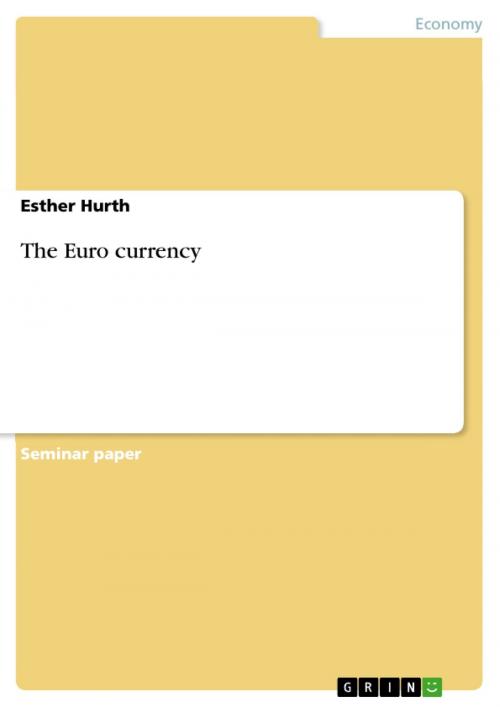| Author: | Esther Hurth | ISBN: | 9783638545723 |
| Publisher: | GRIN Publishing | Publication: | September 17, 2006 |
| Imprint: | GRIN Publishing | Language: | English |
| Author: | Esther Hurth |
| ISBN: | 9783638545723 |
| Publisher: | GRIN Publishing |
| Publication: | September 17, 2006 |
| Imprint: | GRIN Publishing |
| Language: | English |
Seminar paper from the year 2004 in the subject Economics - Monetary theory and policy, grade: 1,0, Australian Catholic University, Brisbane, course: International Affairs, 20 entries in the bibliography, language: English, abstract: On 1 January 1999 the euro has been introduced in the eurozone. First it has only been used commercially in eleven countries which later became twelve (European Commission 2002, Zuckerman 1999), but on 1 January 2002 the euro replaced the national currency of over 300 million European citizens in twelve European countries (Koranteng 2001). The countries that form the world's biggest homogenous financial zone after the United States are Belgium, Germany, Spain, France, Republic of Ireland, Italy, Luxembourg, the Netherlands, Austria, Portugal, Finland and Greece. The latter first did not qualify because of its macroeconomic parameters (Koranteng 2001, Bond Emrich 2001, Mineyev 1998). During the transition period until 28 February 2002, there has been a dual circulation of the euro and the former national currencies (Greene & Travis 2002). The United Kingdom, Sweden and Denmark elected not to join the European Monetary Union (EMU) for several reasons that this paper discusses later (Byrnes-Lenarcic 1998). Every euro coin has a common face but a specific national design on the reverse side (Koranteng 2001), whereas the banknotes have the same design in all the countries (European Commission 2002). The success of that symbol of European integration has been great (Financial Times 2002). According to a Eurobarometer survey in November 2002, most people (51.1%) in the euro area reported they had no difficulties at all with the euro; 49.7% indicated they were 'very' or 'rather' happy to have the euro currency; still 38.7% considered themselves quite unhappy or very unhappy (European Commission 2004). European citizens benefit from the euro when they are travelling. They do no longer need to change currencies and it is easier for them to compare prices. Travelling outside the euro area has become easier as well as the euro is widely accepted in many countries outside the eurozone (European Commission 2004). Even though many consumers have complained about rising prices, the increased price transparency offered by the euro will make prices fall in the long-run (James 2002, Huhne 1999). 'Companies will compete now as they never have before' (Huhne 1999, p.1). Furthermore, marketers will have to reduce their price differences from country to country and will have to offer goods at the prices they charge in their most competitive markets (James 2002, Huhne 1999). [...]
Seminar paper from the year 2004 in the subject Economics - Monetary theory and policy, grade: 1,0, Australian Catholic University, Brisbane, course: International Affairs, 20 entries in the bibliography, language: English, abstract: On 1 January 1999 the euro has been introduced in the eurozone. First it has only been used commercially in eleven countries which later became twelve (European Commission 2002, Zuckerman 1999), but on 1 January 2002 the euro replaced the national currency of over 300 million European citizens in twelve European countries (Koranteng 2001). The countries that form the world's biggest homogenous financial zone after the United States are Belgium, Germany, Spain, France, Republic of Ireland, Italy, Luxembourg, the Netherlands, Austria, Portugal, Finland and Greece. The latter first did not qualify because of its macroeconomic parameters (Koranteng 2001, Bond Emrich 2001, Mineyev 1998). During the transition period until 28 February 2002, there has been a dual circulation of the euro and the former national currencies (Greene & Travis 2002). The United Kingdom, Sweden and Denmark elected not to join the European Monetary Union (EMU) for several reasons that this paper discusses later (Byrnes-Lenarcic 1998). Every euro coin has a common face but a specific national design on the reverse side (Koranteng 2001), whereas the banknotes have the same design in all the countries (European Commission 2002). The success of that symbol of European integration has been great (Financial Times 2002). According to a Eurobarometer survey in November 2002, most people (51.1%) in the euro area reported they had no difficulties at all with the euro; 49.7% indicated they were 'very' or 'rather' happy to have the euro currency; still 38.7% considered themselves quite unhappy or very unhappy (European Commission 2004). European citizens benefit from the euro when they are travelling. They do no longer need to change currencies and it is easier for them to compare prices. Travelling outside the euro area has become easier as well as the euro is widely accepted in many countries outside the eurozone (European Commission 2004). Even though many consumers have complained about rising prices, the increased price transparency offered by the euro will make prices fall in the long-run (James 2002, Huhne 1999). 'Companies will compete now as they never have before' (Huhne 1999, p.1). Furthermore, marketers will have to reduce their price differences from country to country and will have to offer goods at the prices they charge in their most competitive markets (James 2002, Huhne 1999). [...]















